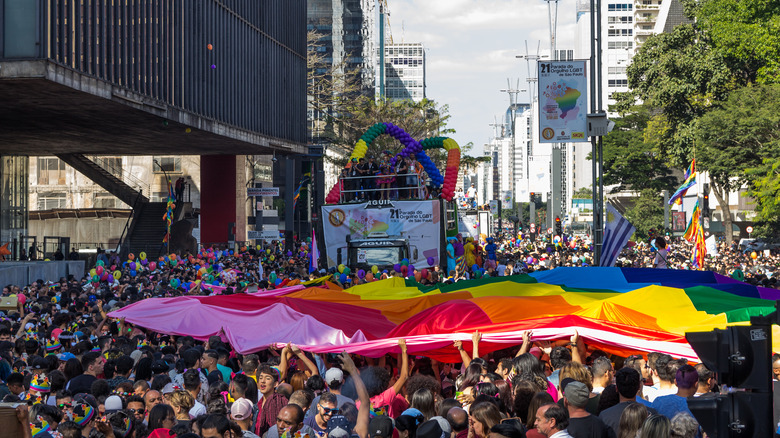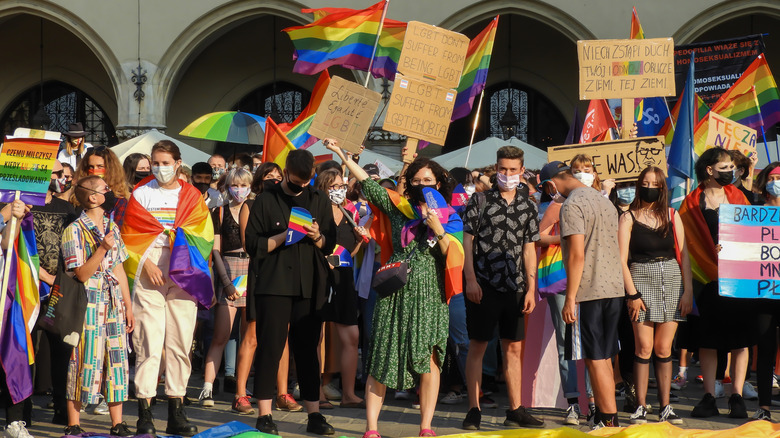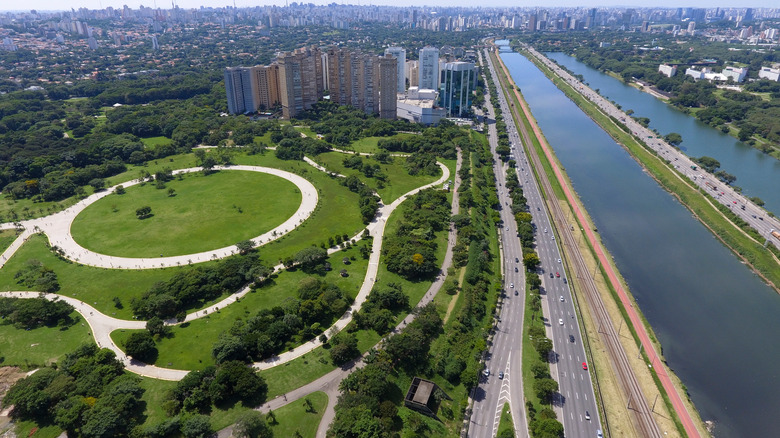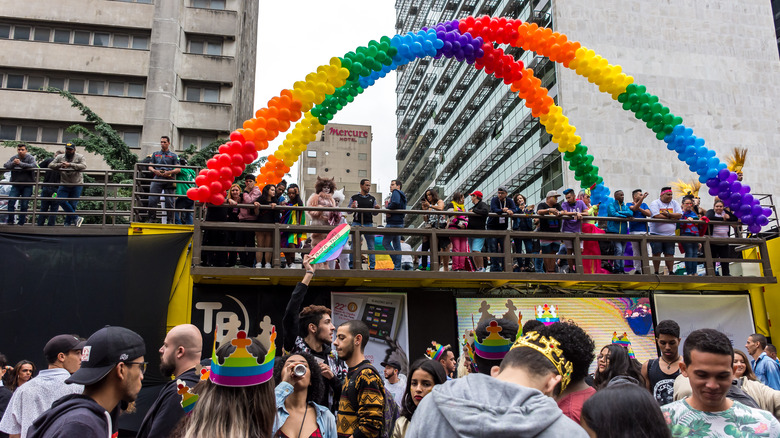The Untold Truth Of The Rainbow Maniac
The name "The Rainbow Maniac" stirs up images of some sort of fluffy, lovable unicorn mascot from the most family-friendly professional sports team in existence. It's a nickname that doesn't spark thoughts of murder and hatred in the way it rightfully should. The Rainbow Maniac goes by another name: the Paturis Park Killer. And, he's far from lovable. See, the type of serial killer the Rainbow Maniac embodies is arguably the worst of the worst. He not only murdered at least 13 individuals but he's believed to have been motivated from an internal place of disdain aimed at a group of people who never wished harm on anyone. A group whose members were simply trying to live a life denied to them for so many years.
The Paturis Park Murders occurred between 2007 and 2009, according to A&E, in Carapicuíba's (a suburb of São Paulo, Brazil) Paturis Park, with the exception of one having been committed at a motel nearby. All but one of the known victims were men, all but one were shot at close quarters in the back of the head, and most of the victims' lifeless bodies were partially stripped of clothing to symbolize what this killer believed to be sexually deviant behavior before being tossed into the park's undergrowth like so much unwanted litter. But the most striking, and probably most disgusting, piece of this killer's MO is the final similarity among the victims: Each of the people murdered by the Rainbow Maniac was LGBT+.
Trying to cleanse the world of LGBT+ folk
In a world where people fear those different than themselves, being LGBT+ is made less than easy from the get-go. Even in countries like the United States where gay marriage has been legal in most states for around a decade now, things can be tough. There are those in the world who oppose your very existence simply because you fall somewhere on the rainbow. Many of these opponents are irritatingly rude at most, but the hatred others carry drives them to commit heinous hate crimes or push legislation that would strip basic human rights away from those in the community. Then, there are those who don't want to simply force LGBT+ folks back in the closet; they want to wipe them from the Earth. It's this headspace where the Rainbow Maniac is believed to reside.
Shortly after the murders were discovered, the local chief of police in charge of the investigation into the Rainbow Maniac case, as detailed by The Guardian, relayed to the press what they believed was the killer's motivation, saying: "In his head, he thinks he is doing a clean-up job." The authorities are certain the Rainbow Maniac passionately hates the LGBT+ community and fancies himself a kind of hero who's helping to cleanse the world of a people he doesn't believe deserve to live. It's pretty messed up, but more people out there think along those same lines than we'd like to believe.
His hunting grounds were prime for his hate crimes
The Rainbow Maniac picked his hunting grounds wisely, as this location was perfect for his hateful crime. According to NBC, Paturis Park was a meeting point for local gay men. What said men did there — well — that's for the imagination to decide. The point is gay men frequented the park, which doesn't seem to be much of a secret since it was reported by most news outlets that covered the story when it broke.
Meet-up locations aren't exactly rare. You can likely find places like this in most major cities, though they usually thrive after dark. But São Paulo, Brazil, holds a special place with the international LGBT+ community. According to Business Insider, the Brazilian city has one of the biggest Pride parades in the world, attracting millions of visitors to the São Paulo streets where they throw down in celebration every June. The city government funds the 2.5-mile parade, which makes it all the more welcoming ... and all the more dangerous when the Paturis Park Killer is on the loose.
Not only was this killer's location prime, but his timing was almost equally as impeccable. The first of the murders took place in July 2007, as noted by The Guardian, just days after the end of LGBT+ Pride month when the community was just coming down from 30 days of celebration. His crimes caught the stragglers and converted the joy seen the month before into a wave of fear.
There's a lot of homophobic violence in Brazil
Many cultures in South America aren't yet accepting of LGBT+ people. It's a sad fact that these hang-ups still exist, especially since issues of personal identity and sexuality affect nobody minding their business, but it's the reality. Even with São Paulo having its own thriving LGBT+ community and Pride celebration, Brazil as a whole is no stranger to homophobic and transphobic violence.
According to The New York Times in 2016, Brazil was considered the most deadly place for members of the LGBT+ population, with a gay or transgender person being murdered every day in the country. The killings are brutal and make the Rainbow Maniac's murders look commonplace. For example, a pair of teachers was found burning in the trunk of a car in 2016 only a few days before another gay man was stabbed to death by a motorcyclist.
The official LGBT+ death toll is high to begin with, but Grupo Gay da Bahia, an LGBT+ activist group that tracks these deaths, believes the numbers are even higher than reported because the police cover up homophobic motives to skew the data. It's the sort of behavior you'd expect from a country that's openly homophobic/transphobic, but Brazil isn't one of those places. They've effectively had legal gay marriage since 2013 and were one of the first countries to offer free antivirals to HIV-positive patients in 1996. But despite a national ethos that preaches tolerance, violence against the LGBT+ community continues to rise.
A former cop was the prime suspect
There's only been one suspect in the Paturis Park Murders that seemed promising. In fact, there's only been one suspect arrested in the case at all. Jairo Francisco Franco, a retired sergeant for the state police, was brought in by authorities on December 10, 2008, in connection with the murders, as NBC points out. Honestly, this dude seemed like the perfect candidate to not pass go, not collect $200, and go directly to jail. Serial killers have left witnesses before, but they usually can only place them near the scene or talking to a victim. The Rainbow Maniac, on the other hand, left behind a witness, who the investigators deemed credible and who allegedly watched Franco blast 12 rounds into a gay man at Paturis Park that August. If that wasn't enough, a second witness came forward who claimed to have seen the suspect frequently stroll through the park scoping out targets.
We've all seen police officers in different countries get off on charges after killing someone. Maybe their friends on the force protect them or their governments don't want to lose face. Whatever the case may be, they surely wouldn't let a retired officer loose suspected of killing 13 people in cold blood with two witnesses who either placed the man at the scene or watched him commit the murder, would they?
The killer is still at large
Many people might look at all the evidence that supports Jairo Francisco Franco as the Rainbow Maniac and think "Yep. That's the killer. That's our guy. We got 'em." But a jury of six believed otherwise, and Franco was allowed to walk free in August of 2011, as Agora São Paulo (a local São Paulo news outlet) notes. You know, despite a witness that claims to have watched Franco unload into a defenseless man in the very same park where 12 of the 13 murders were committed and another witness who says they saw him virtually hunting for targets. And since no killer has been convicted in the Rainbow Maniac case, nobody can officially say one way or another if this man was behind the murders. It leaves a lot for people to think about. Some believe the courts did the right thing. Others think he was let off due to his former police status or sympathy for homophobic hate.
So, what happens now? Well, if Franco is indeed the Rainbow Maniac, it looks like they'll have to wait for new evidence to surface. If Franco is instead innocent, there might be some hope in putting the real criminal behind bars, but it looks like it'll likely take both media and social pressure to get authorities to do so since, according to A&E, no other suspects in the Paturis Park Murders have been arrested. For now, another serial killer gets to run free.





